Use of Binoculars
Caution!
One important word of caution – NEVER look directly at the
sun through binoculars (or a telescope). Doing so could cause permanent
eye damage or blindness!
Parts of the Binoculars:
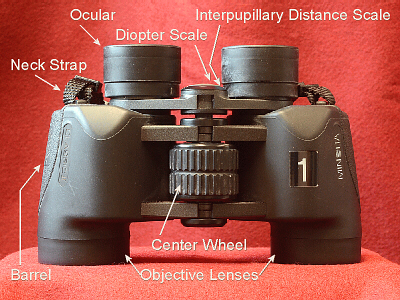 Become familiar with your binoculars and their parts. In your
lab notebook, draw a picture of the binoculars you are using and label the
following, underlined parts.
Become familiar with your binoculars and their parts. In your
lab notebook, draw a picture of the binoculars you are using and label the
following, underlined parts.
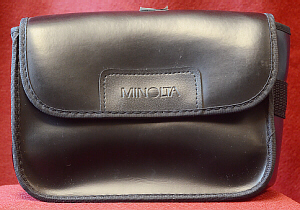
- Obtain the binoculars that correspond
to your assigned seat number.
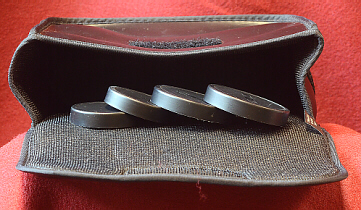
- Place the lens caps back in the case,
and put that back in the drawer until you are done.
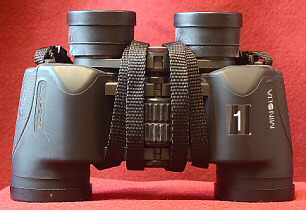
- Note that the neck strap is
(hopefully) coiled neatly around the binoculars. You are expected to make
sure the strap is neatly coiled and the lens caps replaced each time you put
the binoculars away after use.
- The barrels are the main body
of the binoculars and contain prisms that reflect the light from the
objective lenses to the ocular lenses. Note that the barrels are hinged
together at the center.
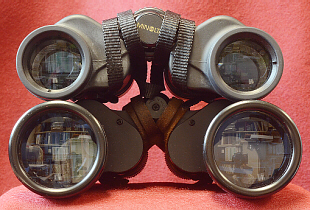
- The objective lenses are on
the “front” of the binoculars – note that these are 35 mm across. These are
achromatic lenses (a- = not, without; chromo = color)
which are made of several layers of glass bonded together to prevent
“rainbows” of color while looking through the binoculars. They are also
coated with a substance to help transmit light better. Binoculars also come
with 50-mm objective lenses, which let in more light, thus are better for
observing under dimmer light conditions. Here, the two sizes are
compared.
- The ocular (ocul = an
eye) lenses (eyepieces) are mounted on the ends of the barrels closest
to your eyes. The oculars can be moved closer together or farther apart to
adjust to the width of your eyes by bending the hinged center of the
binoculars. Practice flexing this hinge.

- Note the interpupillary distance
scale on the central joint of the binoculars. This indicates the
distance between your eyes (70 to 80 mm).

- To the side of the right ocular there is a scale, the diopter scale,
– you will use this to customize the focus to your eyes.

- The center wheel is used to
focus the binoculars.
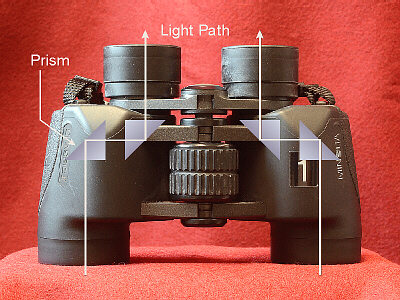
- Inside of the binoculars where you
can’t see them are several prisms. These are used to redirect the
incoming image to your eyes. If you drop the binoculars or bang them on
something, you may jar the prisms out of position, in which case you will
no longer be able to see properly when attempting to use the binoculars.
Thus, it is very important to take good care of the binoculars and not drop
them or bang them on something.
Use of the Binoculars:
- Put the strap around your neck and,
while on field trips, also hold the binoculars so they don't swing. Avoid
dropping or banging the binoculars! Please keep your fingers off the lenses.
If there are fingerprints on the lenses, clean with your breath and lens
paper, being careful to not scratch lenses with gritty dirt.

- Adjust the interpupillary distance
to suit your eyes by bending the center hinge of the binoculars – note the
interpupillary distance scale reading and record in your notebook (which
setting lines up with the dot?).

- Find some object upon which to focus
and use the center wheel (which focuses both oculars together) to adjust the
focus so that it is correct for your left eye.

- Note the dot on the right
eyepiece. Line up the “0” mark of the diopter scale with this dot, then
rotate the right ocular to adjust the diopter setting until the right eye is
in focus, too. Note/draw where on the +/ scale the dot falls. Record
in your notebook for future reference.
- If not already done, record numbers
from scales so that next time you use the binoculars, you can quickly adjust
them to your needs by setting to the appropriate numbers.
- Now that the binoculars are set for
your eyes, use only the center wheel to focus on whatever you wish to see.
- Practice focusing on several targets
(first stationary then moving) such as tree branches, birds, etc. to
familiarize yourself with use of the binoculars.
Storage of the Binoculars:

- Wind the neck strap NEATLY and
securely around the center of the binoculars so that it holds itself in
place.
- Flatten the binoculars and use the
center wheel to move the oculars all the way down if needed so that the
binoculars fit into the drawer.
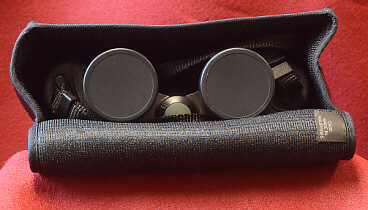
- Place the lens caps on the lenses of
the binoculars. Double check to make sure you have done all of these things
before putting away the binoculars.

- Carefully put away the binoculars.
Return them to their case prior to returning them to the drawer.
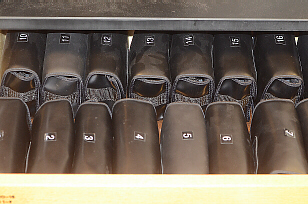
- Place the binoculars/cases in the
drawer in numerical order.
Other Things to Include in Your Notebook
Make sure you have all of the following in your lab notebook:
- all handout pages (in notebook or separate protocol book) should
be in by the first notebook grading
regardless of if we have discussed them, yet, or not
- if/when we discuss binocular use, all notes that you take and all
drawings you make
Copyright © 2010 by D. B. Fankhauser and J. Stein Carter. All rights reserved.
Based on printed protocol Copyright © 1982 D. B. Fankhauser
and © 1993 J. L. Stein Carter.
This page has been accessed  times since 18 Dec 2010.
times since 18 Dec 2010.
 Become familiar with your binoculars and their parts. In your
lab notebook, draw a picture of the binoculars you are using and label the
following, underlined parts.
Become familiar with your binoculars and their parts. In your
lab notebook, draw a picture of the binoculars you are using and label the
following, underlined parts.
 Become familiar with your binoculars and their parts. In your
lab notebook, draw a picture of the binoculars you are using and label the
following, underlined parts.
Become familiar with your binoculars and their parts. In your
lab notebook, draw a picture of the binoculars you are using and label the
following, underlined parts.














